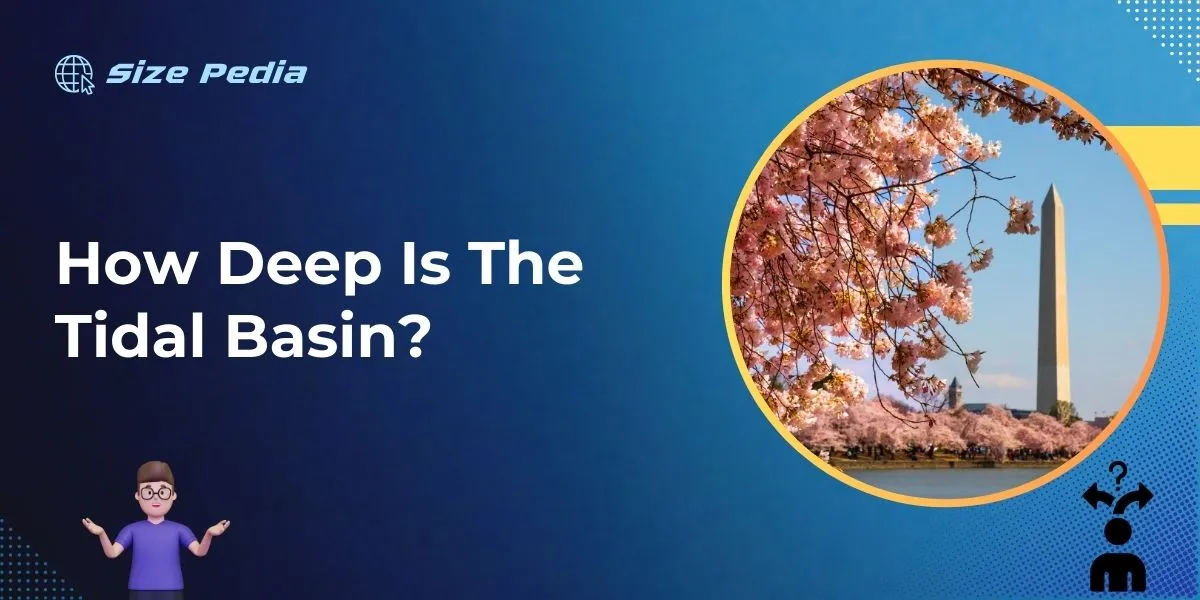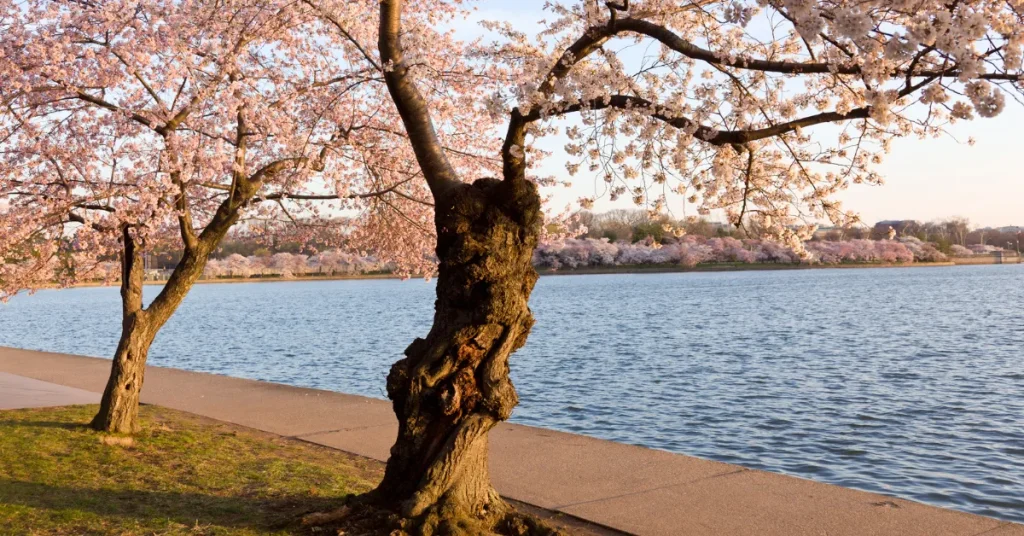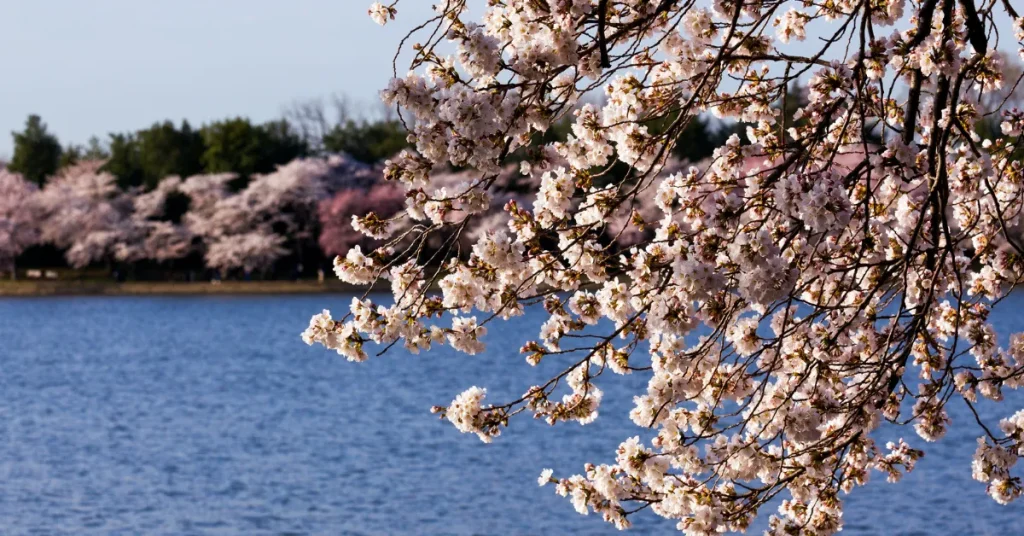The Tidal Basin in Washington, D.C., has an average depth of around 10 feet. Its depth can vary due to tidal changes.
Nestled near the National Mall, the Tidal Basin is a man-made reservoir famous for its cherry blossom trees, which attract visitors from around the world each spring.
It spans approximately 107 acres and serves a dual purpose of both aesthetic appeal and functional necessity, acting as a key element in the capital’s flood management system.
The Tidal Basin’s iconic surroundings include notable memorials—such as the Thomas Jefferson Memorial and the Martin Luther King, Jr. Memorial.
Its serene waters offer a picturesque setting for paddle boating and leisurely strolls, making it a quintessential spot for tourists and locals seeking a tranquil escape amidst the city’s hustle.

Plunging Into The Tidal Basin
The Tidal Basin in Washington D.C. is a man-made reservoir. It is known for its cherry blossoms and paddle boats. Families, photographers, and historians flock to its banks year-round.
The depth of the basin affects these activities. Knowing how deep the water is can ensure a safe and enjoyable visit.
The Heart Of Washington D.c.
The Tidal Basin plays a key role in the city’s flood risk management. It’s also a central piece in the National Cherry Blossom Festival. Let’s dive into its significance.
- Part of West Potomac Park
- Close to landmarks: Jefferson Memorial, MLK Jr. Memorial
- Plays a practical role in draining the Washington Channel
More Than Just Water
But what lies beneath the surface? The depth of the Tidal Basin varies. It’s about 10 feet deep on average. Yet, this number can change. At high tide, it’s deepest. During low tide, it can be significantly shallower.
| Tide Level | Approximate Depth |
| High Tide | 12 feet |
| Low Tide | 8 feet |
It’s important to note the tidal influence. The depth affects the marine life it supports. Birds, fish, and plants thrive in this aquatic environment.
Peering Beneath The Surface

Peering Beneath the Surface of the Tidal Basin offers a glimpse into a world beneath the ripples and reflections that tourists and locals so often admire.
While the surface tells the story of cherry blossoms and paddleboats, the depth houses secrets only a few might know about this historical water feature.
Measuring The Depths
To truly understand the Tidal Basin, knowing its depth is vital. Measurements take place using sonar technology. This technique sends sound waves to the bottom and times how long they take to return.
Experts can then calculate the depth. Results from various locations around the Tidal Basin indicate that the depth varies significantly.
- Shallow areas: Mostly near the edges
- Deepest part: Near the center
Data from these measurements show some spots are as shallow as 18 inches, while others plunge beyond 10 feet. Factors like sediment buildup and seasonal changes affect these numbers.
What Lurks Below
Below the serene surface of the Tidal Basin lies an ecosystem teeming with life.
- Fish species: Resilient marine life thrives in these waters.
- Aquatic plants: Providing oxygen and habitat to wildlife.
Additionally, significant historical artifacts might rest on the basin’s bottom, linked to the location’s past. Trash and debris also accumulate, a reminder of human impact on natural landmarks.
Efforts to clean and maintain the Tidal Basin’s depths are constant, ensuring its preservation for future generations.
Tides Of Change
The Tidal Basin in Washington, DC is more than a picturesque backdrop for cherry blossoms. This iconic body of water mirrors the story of our planet’s ever-changing environment.
As we delve into its depths, we uncover more than the reflections of monuments – we find vestiges of time and nature’s undeniable imprint on our world.
Historical Fluctuations
Throughout history, the Tidal Basin has experienced noteworthy shifts. Here are some key points:
- Built in the late 1800s, it was designed to both beautify and function.
- Dredging and land reclamation altered its depth over time.
- Historic events, such as the 1936 flood, highlighted its vulnerability to natural disasters.
Impact Of Climate On Depth
The Tidal Basin’s current depth is measurably influenced by climate patterns:
| Climate Factor | Impact on Depth |
| Rising sea levels | Increases depth, engulfs pathways |
| Intense storms | Sudden depth surges, disrupts marine life |
| Persistent droughts | Decreases depth, exposes basin floor |
Balancing Act
At the heart of Washington, D.C., lies the Tidal Basin, a crucial water reservoir that serves multiple purposes. The delicate balance of its waters reflects a constant tug-of-war between natural rhythms and human desires.
This equilibrium represents a complex interactive challenge, often referred to as the ‘Balancing Act’.
Ecosystem Interactions
The Tidal Basin’s depth plays a pivotal role in local ecosystem dynamics. It acts as a hub for various species, offering a unique environment for flora and fauna. Ecosystem interactions in this area often include:
- Migratory birds relying on consistent water levels for habitat
- Aquatic plants providing oxygen and shelter within a particular depth range
- Beneficial bacteria breaking down organic matter, which requires stable conditions
Natural cycles like rainfall, river flow, and tidal patterns dictate the Basin’s depth and contribute to an ever-changing but balanced ecosystem.
Human Influence On Water Levels
Human activity has significantly altered the Tidal Basin’s water levels. Infrastructure development, tourism, and recreational usage impose a great impact. Key actions that shape the water levels include:
- Dams and weirs controlling water flow
- Groundwater extraction for urban use
- Land use changes affecting runoff patterns
Historically, the park service has managed water levels to optimize aesthetics and public access, often at odds with natural processes.
Understanding the Tidal Basin’s depth involves recognizing the fragile interplay between natural and human-driven factors. Conscious efforts are required to maintain its health and beauty for future generations.
The Tidal Basin In Numbers

The Tidal Basin, a cherished fixture of Washington, D.C., is not only a picture-perfect spot during cherry blossom season but also a marvel in terms of its dimensions.
Exploring its depths reveals fascinating facts and figures that many might not be aware of. Let’s dive into some numerical insights of this iconic water body.
Average Depths Revealed
Understanding the Tidal Basin’s average depth is vital for comprehending its overall structure and function. Consisting largely of man-made land, the basin has been engineered to fulfill both aesthetic and practical roles.
- Average depth: Approximately 10 feet
- Fluctuates with tides
- Maintained for boating activities
Unexpected Depths Explored
Beyond average figures, the Tidal Basin’s depth can surprise visitors and enthusiasts alike. Certain areas exhibit variations due to natural and man-made influences. Let’s examine the less predictable aspects of its depth.
| Location | Maximum Depth |
| Areas near inflow pipes | Up to 12 feet |
| Near the Jefferson Memorial | Varies between 8-12 feet |
FAQs About How Deep Is The Tidal Basin
What Are The Average Depths Of Tidal Basin?
The Tidal Basin in Washington D. C. has an average depth of approximately 10 feet. This depth can vary slightly with tides and seasons.
Is The Tidal Basin Man-made Or Natural?
The Tidal Basin is a man-made reservoir. It was created in the late 19th century to both beautify the area and to manage the high tides of the Potomac River.
Can You Swim In The Tidal Basin?
Swimming in the Tidal Basin is not permitted. The basin is meant for aesthetic enjoyment and to support the famous cherry blossom trees, as well as a site for national monuments.
How Does The Tidal Basin Impact Washington D.c.?
The Tidal Basin enhances Washington D. C. ‘s landscape significantly. It’s a prime spot for tourism, recreational activities, and provides a picturesque setting for the National Cherry Blossom Festival.
Conclusion
Exploring the Tidal Basin reveals its surprising depth, averaging around 10 feet. This iconic water feature not only enhances Washington D. C. ‘s beauty but also supports its ecosystem.
Dive into its history, and you’ll find a reservoir deep with stories as well as water.
Resources:
1. https://www.nps.gov/subjects/cherryblossom/tidal-basin-loop-trail.htm
